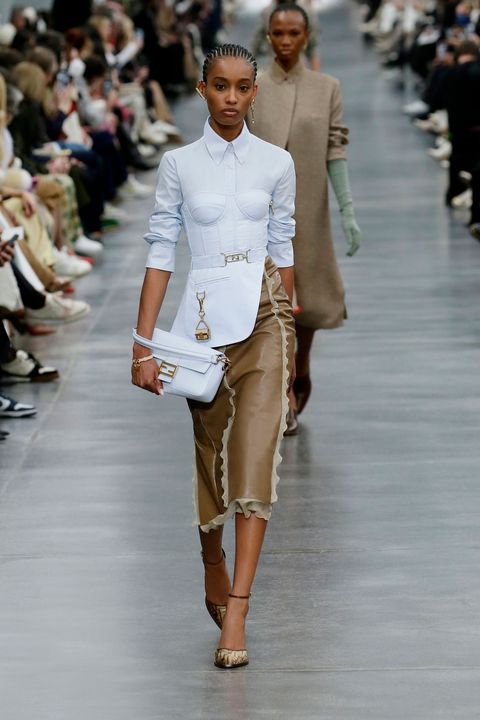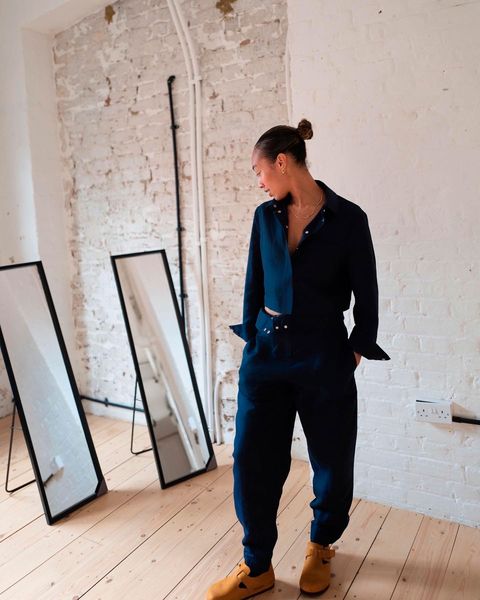Products You May Like
Some cosmic joke must be afoot, because while I’m on the phone with Sarah Jaffe, Sheryl Sandberg announces she’s stepping down from her powerful perch as the COO of Meta. The on-the-nose death knell of the Lean In era is appropriate, because Jaffe and I are having an extremely real conversation about women and work. Her book Work Won’t Love You Back examines the drawbacks of our culture’s extreme devotion to the grind—pretty much the opposite of Sandberg’s kick-down-the-C-suite-doors approach. And while she might not be your typical source for a fashion article, Jaffe’s insight is coming in handy right now.
A frankly confusing array of spliced, deconstructed suiting paraded down the fall runways, in what read as a reaction to our ever-changing work world. The lines between career and private life have become increasingly blurred by remote offices and our digital tethers, and so have those that separate dressing for work and play. We saw this at Coperni, where Arnaud Vaillant and Sébastien Meyer turned out a midriff-baring miniskirt set in a gray flannel that was far from Organization Man—more like Chaos Girl—and at Fendi, where Kim Jones sexed up the prim fabric with short shorts and gloves. The “Working Girl” in pinstripes and the girlboss in the hot-pink suit had given way to a winking, ultra-girly reclamation of masculine officewear tropes. Jaffe sees it as a post-#MeToo reaction: “Sexy workwear, as in, ‘Actually, fuck you, I’m going to wear a hot suit to work, and if you grab my ass, it’s still your problem.’ ” It also feels like a rejection of some of the gender dynamics of the modern workplace. “What COVID showed us,” she says, “is how much unpaid care work women are still responsible for outside the workplace.” And, she adds, in the workplace.
That growing awareness, and the mini revolutions that have come along with it, seems to be driving designers to reinvent the pillars of traditional office dressing. Take the new line Kind Regards, helmed by Shopé Delano, which launched with a convertible jumpsuit style that bridges the gap between work and play. Slashing up pinstriped suiting, as designer Ashlynn Park did for fall, and turning it into a tube top and miniskirt feels like a tiny shot across the bow at the official uniform of patriarchy. While Park’s design tweak is meant to be playful, she says she’s dead serious about workplace equity. As a mother of two, she struggled with fashion’s long hours, and with her own brand, she wanted to set an example for her daughters, “making the right environment in this industry,” which is why her studio finishes out the day at five o’clock.
For Coperni’s Vaillant, he and co-designer Meyer were aiming for something “between an officewear and a teenager vibe.” He says their miniskirt look has been a best-seller, but admits that even he is unsure what circumstances people are buying it for. “You can wear it for a special occasion,” he says, “but you can also wear it at the office, for sure.” (Maybe in France.)
It’s more likely that most of these pieces will never find their way into fluorescent-lit cubicles, if only because of their quality of high camp. “The suit has always been drag,” Jaffe says. It’s a classic garment, one that “changes to a degree that it doesn’t at the same time, and men are always safe in it. As long as they’re wearing a suit, it can be a really bad ill-fitting Donald Trump suit, but they’re still powerful, right?” she says. “Whereas there’s a lot more pressure on women in terms of what we’re supposed to wear. Because you have so many more options, there are so many more ways to be wrong.” So while people might not necessarily be taking to the water cooler in pinstriped minis and suit jackets-turned-tube tops anytime soon, the club is another story. If anything, these aren’t clothes for labor; they’re clothes about labor, our way of grappling with a world where stability and certainty have ebbed. “The romance of work is never perfect,” as Jaffe puts it. “It’s always got cracks in it, and there are so many ways that comes out in the culture.”
This article appears in the October 2022 issue of ELLE.



